JD Edwards EnterpriseOne Sustainability Framework Overview
In today's world, the companies adopt an extensive collection of measures such as policies, procedures, and metrics, to either minimize the adverse effects or to support the favorable contributions to the environment, society, and governance. Environmental, Social, and Governance (ESG) is a set of all such measures, and it provides a means for gauging potential business risks and opportunities within these domains.
The primary focus of the JD Edwards EnterpriseOne Sustainability solution is on the most significant Environmental (E) part of ESG that deals with environmental risks and natural resource management. Collecting environmental data enables businesses to track emissions relative to predefined goals or limits, thus enabling them to identify potential cost-saving and emission-reduction opportunities. It also aids organizations in meeting mandatory and voluntary global environmental reporting requirements. The businesses source the environmental data from multiple channels, thus necessitating the need for manual entry of this information. Proper verification and validation of environmental data is crucial, but this task is time-consuming and burdensome. The JD Edwards Sustainability Framework provides a standardized and optimized way of collecting the environmental information. It focuses on setting up the sustainability foundation by identifying the environmental reference data, gathering the environmental data which reside in different business processes, and storing the data in a repository called Sustainability Activity Ledger.
This figure demonstrates how the Sustainability Framework functions, and depicts its extensibility to integrate with an external software for calculation and reporting of data that is required for environmental reporting purposes.

The key data setup required for Sustainability Framework includes:
- Activity Type: Define the types of environmental activities that generate greenhouse gas (GHG) emissions, such as stationary combustion and mobile combustion. The emissions of any organization need to be categorized under the activity types that are predefined under the GHG protocol. If any task performed by your organization has an impact on the environment, then it is called an activity, and the activity can be categorized under a certain type, called activity type. For example, if you are using fuel in boiler or any other machine which is stationary, it comes under the activity type of stationary combustion.
- Scope: Set up emission scope codes to categorize an environmental activity
into one of the scopes defined by the GHG Protocol. All activity types are grouped
under one of these scopes defined by GHG:
-
Scope 1: Direct GHG emissions from sources owned or controlled by the company. For example, the activity type stationary combustion comes under Scope 1.
-
Scope 2: Indirect GHG emissions from the purchased energy.
-
Scope 3: Other indirect GHG emissions that are not included in Scope 2.
-
- Determinant Type: Set up the determinant types such as fuel types, vehicle types, and energy types required for different activity types.
- Determinant: Set up various determinants such as diesel and natural gas, and assign them to a determinant type. The determinants determine the emission factor of an activity. For example, for the activity type of stationary combustion, if the determinant diesel is used, the emission will be different from the emission that the determinant natural gas usage will cause.
- Emission Types: Set up emission types to define the types of GHG emissions that result from the environmental activities. The examples of emission gases are carbon dioxide (CO2), methane (CH4), nitrous oxide (N2O), and other fugitive emissions that include sulphur hexafluoride (SF6), nitrogen trifluoride (NF3), and so on.
The Sustainability Framework system records the environmental data from various JD Edwards applications and stores this data as activity records in the Sustainability Activity Ledger table. The Sustainability Activity Ledger application enables you to enter and modify the activity data. You can use the JD Edwards in-built capabilities to import and export the environmental data. You can then use these components to calculate carbon emissions, and for other reporting purposes.